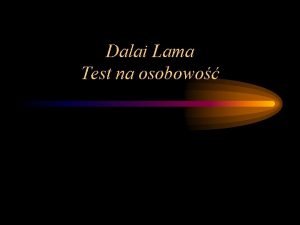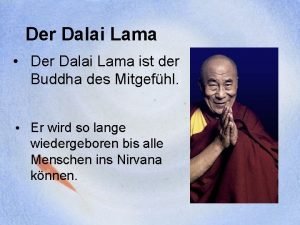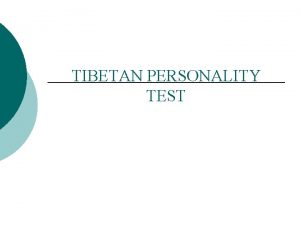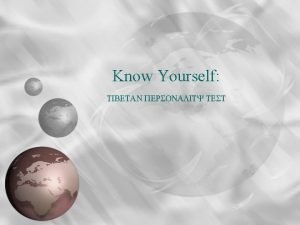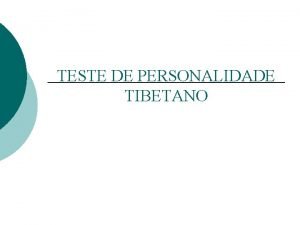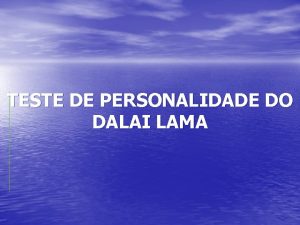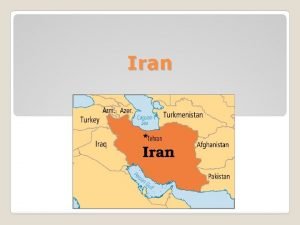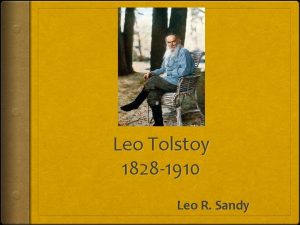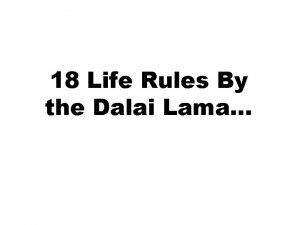THE DALAI LAMA 1935 Universal Compassion Leo R











- Slides: 11

THE DALAI LAMA 1935 Universal Compassion Leo R. Sandy

Dalai lama • The 14 th Dalai Lama, leader of six million Tibetans, describes himself as “only an ordinary human being” and exemplifies a high level of humility • He is one of the foremost proponents of nonviolence • His message and acts of compassion earned him the Nobel Peace Prize in 1989 • The Dalai Lama (Lhamo Dhonddrub) was born to peasant farmers in Shangri La on top of the Himalayan mountains in Takster, Tibet • At age 2, a group of monks visited him and his parents, and declared him the 14 th Dalai Lama – a manifestation of the Bodhisattva (enlightened being) of Compassion

Lama cont’d • He was then taken from his parents to Potala Palace in Tibet’s capital, Lhasa where he was renamed Tenzin Gyatso (Ocean of Wisdom) • At age 4, he was overwhelmed by his crimson-colored robes as he was enthroned in an elaborate ceremony as Dalai Lama • He later recalled how unhappy he had been not understanding all that happened to him • He was intensely tutored by the elder monks at the palace • One of his most important lessons involved a parrot who did not respond to his attempts to play with it. He was so upset that he hit the bird with a stick resulting in the bird’s flight at the sight of the young boy

Lama cont’d • The lesson he learned was that to make friends, one must use compassion and not force. This stayed with him for the rest of his life and became his life’s mission – to spread compassion among humans • When China invaded Tibet in 1950, the Dalai Lama was only 15 years old and was expected by his people to respond to this invasion • Maintaining his belief in nonviolence, the young Dalai Lama, tried to negotiate with Mao Tse Tung, China’s leader, for 9 years but to no avail • Resistance to China’s invasion was met with beheadings, burnings, crucifixion, vivisection, burying alive and tearing out tongues so the Tibetans could not voice support for the Dalai Lama

Lama cont’d • In 1959, the Dalai Lama believed that the only way to prevent further bloodshed was if he left the country so he traveled through desolate mountain terrain, eventually finding asylum in Dharamsala, India • Later, tens of thousands of Tibetans also fled their country, many joining the Dalai Lama in India • The International Commission of Jurists declared that China “had violated 16 articles of the Universal Declaration of Human Rights and was guilty of genocide in Tibet” • He immediately embarked on a global quest for international assistance

Lama cont’d • The U. N. passed three resolutions for China to respect Tibetan’s human rights • In India, the Dalai Lama established a system of rehabilitation, education, and cultural preservation for exiled Tibetans • He also drafted a democratic constitution for a future Tibet with a proposal for a Five Point Peace Plan with China • He maintained compassion for the Chinese and eschewed violence. He also believed that the majority of Chinese were committing acts of kindness while only a small minority were inflicting cruelty on Tibetans • More than a million Tibetans have died as a result of China’s policy and over 75 percent are living in poverty

Lama cont’d • China has also degraded the Tibetan environment by extracting natural resources and dumping nuclear waste • Tensions between China and India have increased through the weakening of the Tibetan buffer. China has placed a quarter of a million troops in Tibet with also the possibility of nuclear warheads • The Dalai Lama continues to travel the world meeting with heads of state and ordinary people, seeking not only support for Tibetans but also for world peace and justice • For the Dalai Lama, compassion is the basic requirement for peace, and he was particularly buoyed by the end of South African apartheid and the fall of the Berlin wall

Lama cont’d • The Dalai Lama sees all people as brothers and sisters. As he has aged, he has come to the belief that when we have led a full, productive, and meaningful life, we can find some comfort in that before we die • Because of his travels and writings, he is known throughout the world, and is a beacon of peace for humanity

Dalai Lama Quotes • My religion is simple; my religion is kindness • Ultimately humanity is one, and this small planet is our only home. If we are to protect this home of ours, each of needs to experience a vivid sense of universal altruism and compassions • Peace means, I think, any action out of compassion, out of sense of concern, out of respect for others’ rights – that’s peace • Compassion and love are not mere luxuries. As the source of inner and external peace, they are fundamental to the continued survival of our species

Video Dalai Lama speaks on Inner Peace, Inner Value, & Mental States

References Beller, K. , & Chase, H. (2008). Great peacemakers: True stories from around the world. Sedona, AZ: LTS Press Dalai Lama speaks on Inner Peace, Inner Values, & Mental States. Retrieved from https: //www. youtube. com/watch? v=Xnr 2 SPHLra. I&feature=player_embedded

